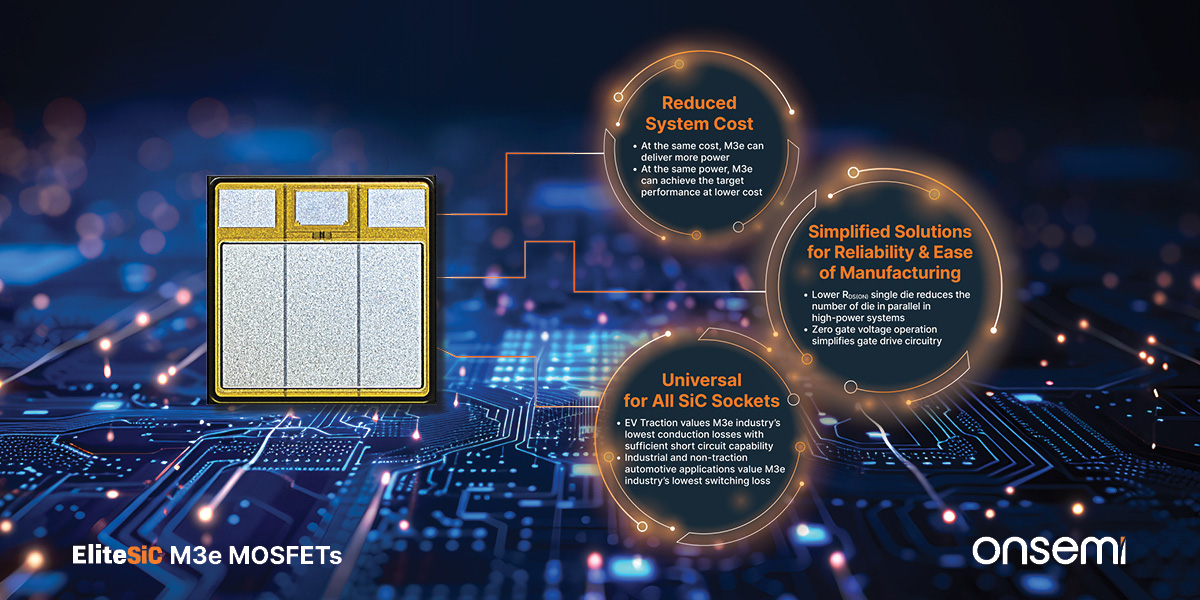News: Microelectronics
18 July 2024
onsemi launches EliteSiC M3e MOSFETs as its latest-generation silicon carbide technology platform
In the face of escalating climate crises and a dramatic rise in global energy demands, governments and industries are committing to ambitious climate goals aimed at mitigating environmental impact and securing a sustainable future. Key to these efforts is the transition to electrification to reduce carbon emissions and embrace renewable energy resources.
In a step towards accelerating this global transition, intelligent power and sensing technology firm onsemi of Scottsdale, AZ, USA has introduced EliteSiC M3e MOSFETs as its latest-generation silicon carbide technology platform, sampling now in the industry-standard TO-247-4L package. The firm also disclosed plans to release multiple additional generations through 2030.

“The future of electrification is dependent on advanced power semiconductors. Today’s infrastructure cannot keep up with the world’s demands for more intelligence and electrified mobility without significant innovations in power. This is critical to the ability to achieve global electrification and stop climate change,” says Simon Keeton, group president of onsemi’s Power Solutions Group. “We are setting the pace for innovation, with plans to significantly increase power density in our silicon carbide technology roadmap through 2030 to be able to meet the growing demands for energy and enable the global transition to electrification.”
The firm reckons that its EliteSiC M3e MOSFETs will play a fundamental role in enabling the performance and reliability of next-generation electrical systems at lower cost per kW, influencing the adoption and effectiveness of electrification initiatives. With the ability to operate at higher switching frequencies and voltages while minimizing power conversion losses, this platform is suitable for a wide range of automotive and industrial applications such as electric vehicle powertrains, DC fast chargers, solar inverters and energy storage solutions. Additionally, the EliteSiC M3e MOSFETs can enable the transition to more efficient, higher-power data centers to meet the exponentially increasing energy demands that power a sustainable artificial intelligence engine, onsemi adds.
Platform delivers efficiency leap
Onsemi says that, through its design engineering and manufacturing capabilities, the EliteSiC M3e MOSFETs achieve a significant reduction in both conduction and switching losses on the field-proven planar architecture. Compared to previous generations, the platform can reduce conduction losses by 30% and turn-off losses by up to 50% (based on internal testing, compared with the EliteSiC M3T MOSFETs). By extending the life of SiC planar MOSFETs and delivering what is claimed to be industry-leading performance with EliteSiC M3e technology, onsemi says that it can ensure the robustness and stability of the platform for critical electrification applications.
The EliteSiC M3e MOSFETs also offer what is claimed to be the industry’s lowest specific on-resistance (RSP) with short-circuit capability which is critical for the traction inverter market that dominates SiC volume. Packaged in onsemi’s discrete and power modules, the 1200V M3e die delivers substantially more phase current than previous EliteSiC technology, resulting in about 20% more output power in the same traction inverter housing. Conversely, a fixed power level can now be designed with 20% less SiC content, saving costs while enabling the design of smaller, lighter and more reliable systems.
Additionally, onsemi provides a broader portfolio of intelligent power technologies including gate drivers, DC-DC converters and e-Fuses to pair with the EliteSiC M3e platform. The end-to-end onsemi combination of optimized, co-engineered power switches, drivers and controllers are said to enable advanced features via integration, lowering overall system cost.
Accelerating EliteSiC product development roadmap
Global energy demands are projected to soar over the next decade, making the need for increased power density in semiconductors paramount. onsemi says that its innovation across its silicon carbide roadmap – from die architectures to novel packaging techniques – will continue to address the general industry demand for increased power density.
With each new generation of silicon carbide, cell structures will be optimized to efficiently push more current through a smaller area, increasing power density. When coupled with the company’s packaging techniques, onsemi says that it will be able to maximize performance and reduce package size. By applying the concepts of Moore’s Law to the development of silicon carbide, onsemi says that it can develop multiple generations in parallel and accelerate its roadmap to bring several new EliteSiC products to market at an accelerated pace through 2030.
“We are applying our decades of experience in power semiconductors to push the boundaries of speed and innovation in our engineering and manufacturing capabilities to meet the rising global energy demands,” says Dr Mrinal Das, senior director of technical marketing, Power Solutions Group, onsemi. “There is a huge technical interdependency between the materials, device and package in silicon carbide. Having full ownership over these key aspects allows us to have control over the design and manufacturing process and bring new generations to market much faster.”
onsemi realigns business groups to expand product portfolio and accelerate growth









